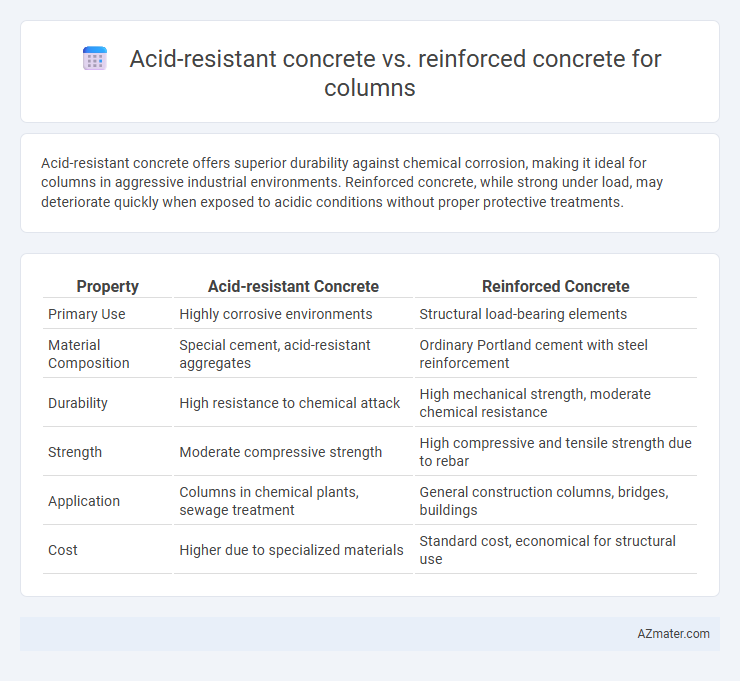Acid-resistant concrete offers superior durability against chemical corrosion, making it ideal for columns in aggressive industrial environments. Reinforced concrete, while strong under load, may deteriorate quickly when exposed to acidic conditions without proper protective treatments.
Table of Comparison
| Property | Acid-resistant Concrete | Reinforced Concrete |
|---|---|---|
| Primary Use | Highly corrosive environments | Structural load-bearing elements |
| Material Composition | Special cement, acid-resistant aggregates | Ordinary Portland cement with steel reinforcement |
| Durability | High resistance to chemical attack | High mechanical strength, moderate chemical resistance |
| Strength | Moderate compressive strength | High compressive and tensile strength due to rebar |
| Application | Columns in chemical plants, sewage treatment | General construction columns, bridges, buildings |
| Cost | Higher due to specialized materials | Standard cost, economical for structural use |
Introduction to Concrete Columns
Concrete columns serve as critical load-bearing elements in construction, designed to resist compressive forces and provide structural stability. Acid-resistant concrete incorporates specialized additives and aggregates to enhance chemical durability against acidic environments, while reinforced concrete columns embed steel reinforcement bars to improve tensile strength and ductility. Selecting between acid-resistant and reinforced concrete depends on environmental exposure and load-bearing requirements, ensuring longevity and safety in structural applications.
Overview of Acid-Resistant Concrete
Acid-resistant concrete is engineered with specialized aggregates and chemical-resistant cementitious materials to withstand highly corrosive environments, making it ideal for columns exposed to acidic substances in industrial settings. It offers enhanced durability and longevity compared to traditional reinforced concrete, which primarily provides structural strength but lacks inherent chemical resistance. This concrete type reduces maintenance costs and structural degradation in acid-prone areas by preventing corrosion and deterioration of the column matrix.
Understanding Reinforced Concrete
Reinforced concrete combines concrete's compressive strength with steel rebar's tensile strength, making it ideal for structural columns subjected to heavy loads and bending forces. Acid-resistant concrete incorporates special cement and aggregates that prevent degradation from acidic environments, ensuring longevity in chemical plants or wastewater treatment facilities. Understanding reinforced concrete's composition and behavior helps engineers select appropriate materials for columns depending on mechanical demands and environmental exposure.
Key Material Properties Compared
Acid-resistant concrete for columns features enhanced chemical durability due to additives like silica fume and acid-proof aggregates, providing superior resistance to low pH environments and aggressive acids. Reinforced concrete incorporates steel reinforcement, offering high tensile strength and load-bearing capacity but remains vulnerable to corrosion in acidic conditions without protective coatings. Key material properties comparison highlights acid-resistant concrete's superior chemical stability versus reinforced concrete's mechanical robustness, with the choice depending on environmental exposure and structural requirements.
Durability in Aggressive Environments
Acid-resistant concrete enhances column durability by incorporating specialized aggregates and chemical admixtures that prevent degradation in highly acidic environments, significantly outperforming standard reinforced concrete in resisting chemical attacks. Reinforced concrete columns rely on steel reinforcement for structural strength but are vulnerable to corrosion and deterioration when exposed to aggressive acidic conditions, compromising long-term durability. Optimizing column performance in aggressive environments requires selecting acid-resistant concrete to maintain integrity and prolong service life.
Structural Performance and Load Capacity
Acid-resistant concrete exhibits superior durability and chemical stability compared to reinforced concrete, making it ideal for columns exposed to aggressive acidic environments. Reinforced concrete provides high tensile strength and load capacity due to embedded steel reinforcement, enhancing its structural performance under compressive and bending stresses. Columns constructed with acid-resistant concrete maintain long-term integrity and load-bearing capacity in corrosive conditions, whereas reinforced concrete requires protective measures to prevent steel corrosion and maintain structural reliability.
Maintenance Requirements and Longevity
Acid-resistant concrete offers superior durability in aggressive chemical environments, significantly reducing maintenance needs compared to standard reinforced concrete columns. Reinforced concrete requires regular inspections and repairs to prevent corrosion of steel reinforcement, often leading to higher long-term maintenance costs. Acid-resistant formulations extend the lifespan of columns by minimizing chemical degradation, ensuring greater structural integrity and longevity in industrial or corrosive settings.
Cost Implications and Project Budgeting
Acid-resistant concrete typically incurs higher initial costs compared to reinforced concrete due to specialized materials like silica fume and chemical-resistant additives designed to withstand corrosive environments. Reinforced concrete, while more economical upfront, may lead to increased maintenance expenses over the project lifespan when exposed to acidic conditions, impacting long-term budgeting. Project budgeting must account for the trade-off between higher initial investment in acid-resistant concrete and potential durability savings, ensuring cost-effectiveness aligned with environmental exposure risk assessments.
Applications: Best Uses for Each Concrete Type
Acid-resistant concrete is ideal for industrial columns exposed to harsh chemical environments, such as wastewater treatment plants and chemical processing facilities, where durability against corrosion is critical. Reinforced concrete columns excel in structural applications requiring high-load bearing capacity and seismic resistance, commonly used in commercial buildings, bridges, and residential construction. Selecting acid-resistant concrete ensures longevity in corrosive settings, while reinforced concrete provides strength and flexibility for general structural support.
Conclusion: Selecting the Right Concrete for Columns
Selecting the right concrete for columns depends primarily on the environmental conditions and structural requirements. Acid-resistant concrete offers superior durability and chemical resistance in corrosive environments, significantly extending column lifespan where acid exposure is prevalent. Reinforced concrete provides robust structural strength and load-bearing capacity suitable for general construction but requires protective measures against chemical attack to ensure longevity in harsh conditions.

Infographic: Acid-resistant concrete vs Reinforced concrete for Column
 azmater.com
azmater.com